Creating Byzantine-inspired jewelry blends ancient aesthetics with modern craftsmanship. You’ll need gold or silver wire for filigree, traditional gemstones like garnets and pearls, and tools for both delicate handwork and contemporary techniques. Today’s jewelers combine CAD design, 3D printing, and laser cutting with time-honored methods like granulation and cloisonné enameling. This fusion creates authentically styled pieces that remain practical for everyday wear. The perfect balance of imperial heritage and modern technology awaits your exploration.
Understanding the Essence of Byzantine Jewelry Heritage

While contemporary jewelry may dazzle with precision-cut gems and machine-perfect settings, Byzantine jewelry captivates through its rich cultural depth and handcrafted intricacy.
When you examine these historical treasures, you’re witnessing the intersection of technical mastery and profound symbolism.
Byzantine jewelry served as more than decoration—it communicated wealth, status, and religious devotion. From the 4th to 15th centuries, pieces featured elaborate interwoven patterns and Christian motifs like crosses and saints, especially after the fifth century.
Artisans worked primarily with gold and silver, incorporating emeralds and pearls for their symbolic value and visual appeal.
The distinctive character of Byzantine jewelry emerges through specialized techniques including granulation, filigree, and opus interrasile, creating the ornate aesthetic that’s become synonymous with this influential artistic tradition.
Essential Materials for Crafting Byzantine-Inspired Pieces
When crafting Byzantine-inspired jewelry, you’ll need to master the selection and treatment of precious metals like gold and silver, incorporating patination techniques that create an authentic aged appearance.
Your gemstone choices—garnets, emeralds, and pearls—should reflect the imperial palette while complementing the intricate metalwork that defines this style.
Thin filigree wire becomes your essential tool for creating the elaborate scrollwork and delicate patterns that capture the essence of Byzantine craftsmanship.
Metals and Patination Techniques
Three primary metals form the foundation of authentic Byzantine-inspired jewelry: gold, silver, and bronze.
These precious metals reflect the luxurious materials historically favored by Byzantine artisans. You’ll achieve distinctive character in your pieces through patination—applying treatments that create rich, textured finishes resembling ancient artifacts.
For silver elements, liver of sulfur delivers a beautiful antiqued appearance, highlighting intricate details in your designs.
Consider experimenting with metal alloy combinations; mixing copper with silver produces varied colors that emulate Byzantine polychrome aesthetics.
You can also develop unique colorations through controlled heat treatment and oxidation, allowing for creative expression while maintaining historical authenticity.
These techniques transform contemporary materials into pieces with the depth and character of Byzantine treasures.
Gemstone Selection Fundamentals
Selecting the right gemstones forms the cornerstone of authentic Byzantine-inspired jewelry creation. When exploring gemstone selection fundamentals, prioritize garnets, emeralds, and pearls—precious gemstones that historically signified wealth and status in Byzantine society.
These eastern-sourced stones paired with polished cabochon techniques enhance color depth while simplifying attachment to intricate metalwork.
If you’re facing scarcity of authentic precious gemstones, consider enamel as a vibrant alternative that maintains the colorful aesthetic true to Byzantine traditions. Look for stones with rich hues and distinctive patterns that evoke the opulence of historical pieces.
Remember to incorporate religious motifs like crosses or angels when setting your gems, reflecting the spiritual significance central to Byzantine Orthodox tradition and adding authentic cultural resonance to your creations.
Filigree Wire Essentials
The cornerstone of authentic Byzantine-inspired jewelry lies in mastering filigree wire techniques. When crafting Byzantine jewellery, you’ll need high-quality gold or sterling silver wire in varying diameters—thinner gauges for delicate spirals and loops, thicker ones for structural elements.
You’ll require specialized tools including a soldering iron, fine tweezers, and a precision saw to manipulate the wire with the accuracy this ancient art demands.
The traditional Byzantine approach involves twisting and coiling wire to create distinctive shapes before soldering them together into complex patterns.
For truly enchanting pieces, consider complementing your filigree work with colored gemstones or enamel. This combination not only enhances the ornate wirework but also authentically reflects the vibrant aesthetic characteristic of historical Byzantine jewellery examples.
Adapting Ancient Granulation Techniques for Modern Studios
While Byzantine artisans meticulously placed tiny gold beads by hand using ancient fusion methods, today’s jewelers can achieve similar stunning effects with modern adaptations. You’ll find that digital soldering stations and laser welding technologies provide precise temperature control, preventing your granules from melting while ensuring secure attachment.
| Traditional Technique | Modern Adaptation |
|---|---|
| Charcoal fire heating | Digital temperature control |
| Copper salt fusion | Laser welding technology |
| Limited material options | Mixed media with enamel/stones |
| Guild-based training | Accessible workshops/courses |
Don’t hesitate to experiment with colored enamels or synthetic stones alongside your granulation work. As you develop your skills, you’re not only creating beautiful jewelry but also preserving this historic technique. Many training opportunities now exist specifically for artisans wanting to master granulation in contemporary settings.
Mastering Contemporary Filigree Methods for Byzantine Aesthetics
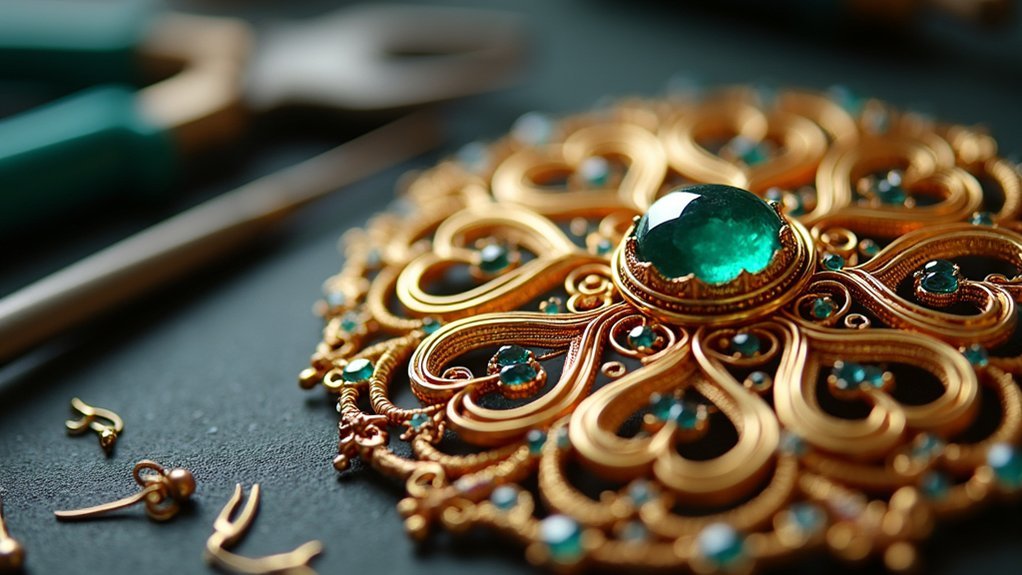
Ancient Byzantine filigree techniques have evolved dramatically in modern studios, yet they still capture the breathtaking intricacy that defined imperial jewelry.
You’ll find today’s artisans using precision tools to shape fine gold and silver wires into the elaborate spirals and patterns characteristic of Byzantine aesthetics.
When creating filigree pieces, you can incorporate traditional motifs like crosses or geometric designs that honor their spiritual origins while appealing to modern sensibilities.
The advanced techniques available now allow you to craft lightweight, comfortable pieces that retain their historical elegance without sacrificing durability.
Digital Design Tools for Byzantine Motif Creation
How remarkably the digital age has transformed Byzantine jewelry creation!
You’ll find vector-based programs like Adobe Illustrator and CorelDRAW indispensable for crafting precise, scalable Byzantine motifs with the intricate detail this style demands.
For three-dimensional work, Rhino and Blender allow you to visualize complex Byzantine forms before production, saving countless hours of physical prototyping.
These digital design tools integrate seamlessly with CAD programs that excel at generating the elaborate filigree and engraving patterns quintessential to Byzantine aesthetics.
When you’re ready for production, digital fabrication techniques, particularly 3D printing, can create casting molds that capture minute details.
Don’t overlook online libraries with high-resolution Byzantine imagery—they’re invaluable resources for studying authentic motifs and understanding the symbolic language of this historic art form.
Gemstone Selection and Setting in the Byzantine Tradition
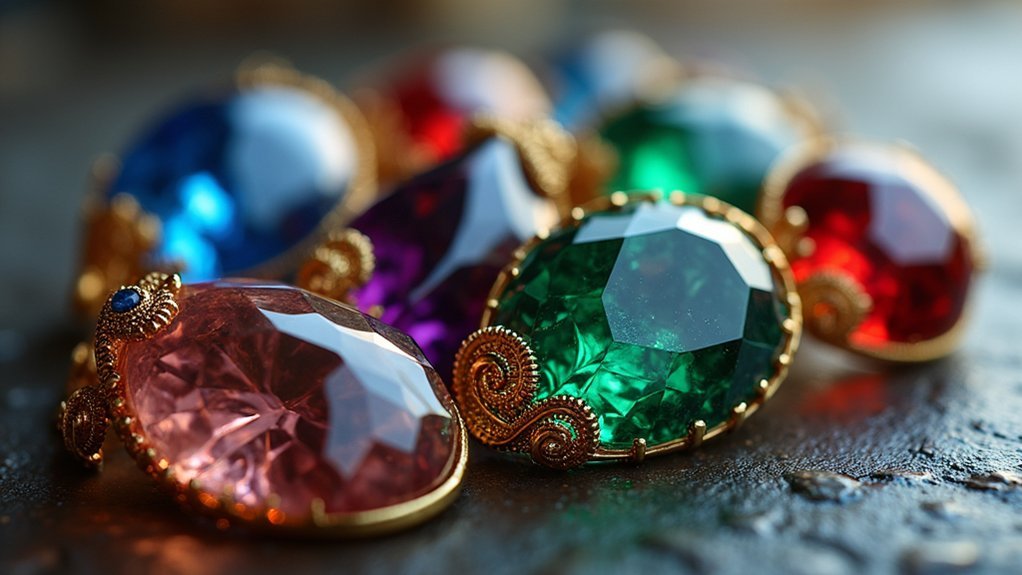
Rich in symbolism and opulent in appearance, Byzantine jewelry owes much of its distinctive character to the deliberate selection and masterful setting of gemstones. Your gemstone selection should focus on the vibrant colors and natural beauty that defined Byzantine aesthetics, rather than modern faceting techniques.
| Stone Type | Traditional Setting |
|---|---|
| Garnets & Emeralds | Gold collets emphasizing size |
| Pearls | Drilled and wire-attached |
| Cabochons | Smooth, rounded settings |
When setting stones in Byzantine-inspired pieces, you’ll want to employ techniques that showcase their inherent qualities. Consider using cloisonné enamel alongside your gemstones for authentic polychrome effects. The embossing and chasing methods add textural depth that complements your gemstone selection, creating pieces that honor the tradition of displaying wealth and status through magnificent natural materials.
Incorporating Religious Symbolism in Modern Designs
While ancient Byzantine artisans created jewelry primarily for court and church settings, today’s designers adapt these sacred motifs for everyday wear without diminishing their spiritual significance.
When you’re designing Byzantine-inspired pieces, you’ll find religious symbols serve as powerful focal points that connect wearers to centuries of tradition.
Incorporate filigree work around crosses, angels, and saints to enhance their ornate beauty. You’ll achieve stunning results by applying enamel techniques to add vibrant colors that make these symbols visually striking.
Consider adding intaglio carvings depicting biblical scenes for depth and narrative quality.
Don’t overlook the symbolic power of gemstones—garnets and amethysts aren’t just decorative but carry spiritual resonance.
These stones, strategically placed within your designs, will complement religious motifs while providing the divine protection they’ve symbolized for centuries.
Reinterpreting Imperial Jewelry Elements for Today’s Market
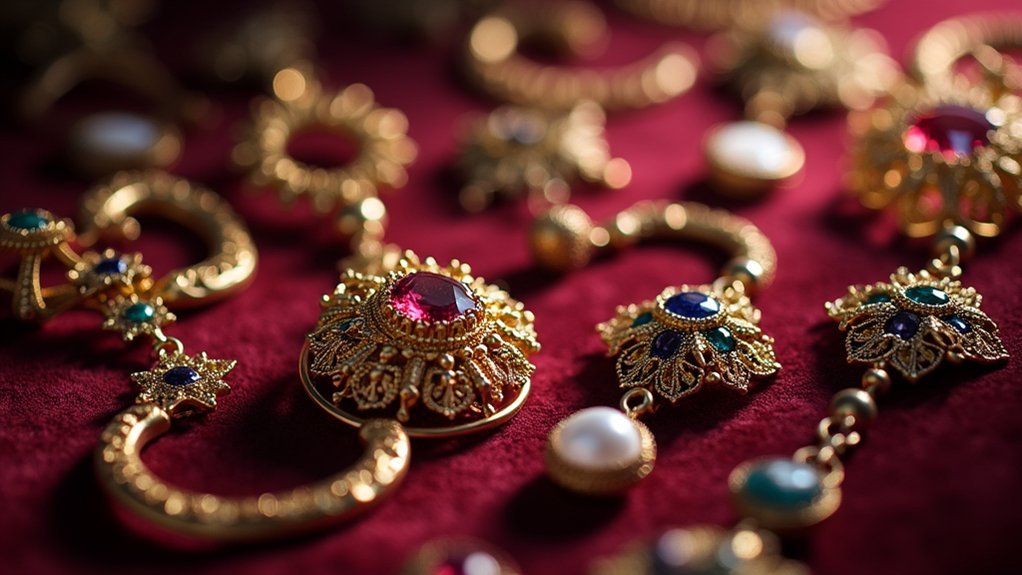
Modern jewelry designers are breathing new life into Byzantine imperial aesthetics through innovative combinations of ancient filigree work with technological advancements in metalsmithing.
You’ll find traditional cabochon stone settings reimagined in contemporary pieces, where luxurious gemstones like amethysts and garnets provide striking focal points against intricate metalwork.
The revival of cloisonné enamel techniques offers you vibrant color possibilities that honor historical craftsmanship while meeting today’s demand for wearable art with cultural significance.
Filigree Meets Tech
Three revolutionary technologies have transformed Byzantine-inspired filigree from ancient art to contemporary luxury.
Laser cutters now produce impossibly fine wire patterns that maintain the delicate aesthetic of traditional filigree while ensuring consistency across production runs. You’ll find these pieces offer the ornate beauty of historical designs without the fragility.
3D printing has revolutionized prototyping, allowing you to experiment with complex Byzantine patterns before committing to final materials.
Meanwhile, advanced metalworking tools enable you to combine sterling silver with synthetic gemstones, creating affordable luxury pieces that honor Byzantine heritage.
This technological evolution hasn’t replaced craftsmanship—it’s enhanced it.
Cabochon Stone Settings
Imperial elegance finds its modern expression through cabochon stone settings, a signature element of Byzantine jewelry now enchanting today’s luxury market.
When you’re working with these polished, non-faceted gems, you’ll notice how they emphasize pure color and shape, creating powerful focal points in your designs.
Set your cabochon stones in gold or silver mounts to honor Byzantine craftsmanship while speaking to contemporary sensibilities. You’ll find garnets and emeralds particularly effective in capturing the luxurious essence of historical pieces.
Don’t hesitate to incorporate synthetic options when natural gems aren’t practical.
For authentic Byzantine flair, surround your cabochons with filigree work and engraving, maintaining the symmetry and proportion so cherished in imperial designs.
This marriage of ancient techniques with modern applications creates jewelry that’s both timeless and distinctly marketable.
Enamel Revival Strategies
Vibrant cloisonné techniques stand at the heart of today’s Byzantine enamel revival, offering jewelers limitless creative possibilities.
You’ll find that modern synthetic enamels provide broader color options and enhanced durability compared to traditional glass-based formulations, while remaining true to historical aesthetics.
Try experimenting with layered enamel work to create depth and texture that captures the rich visual complexity of imperial designs.
When you incorporate traditional motifs like crosses and geometric patterns, you’re bridging centuries of artistic tradition with contemporary fashion demands.
Consider attending specialized workshops to master these ancient techniques.
The growing popularity of enamel classes enables you to learn authentic methods while developing your unique interpretative style.
Enameling Techniques: From Cloisonné to Modern Alternatives
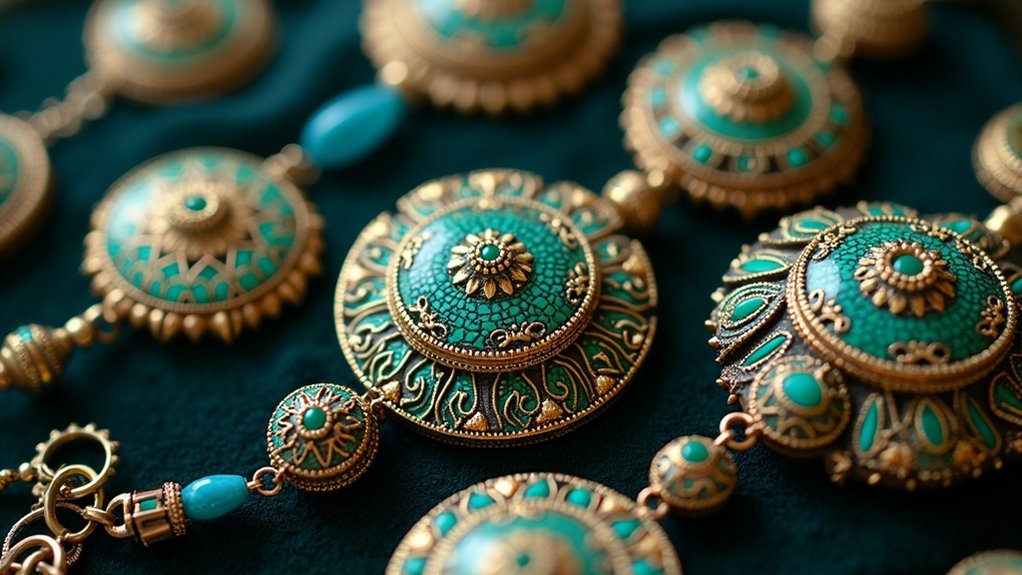
At the heart of Byzantine jewelry’s enduring appeal lies the mastery of enameling—a technique that transforms simple metal into luminous works of art. When you’re working with traditional cloisonné, you’ll create metal compartments to hold vibrant colored enamel, producing intricate designs characteristic of Byzantine craftsmanship.
Today’s enameling techniques offer exciting alternatives. You can use powdered glass enamel fused to metal at high temperatures, allowing greater design flexibility.
The champlevé technique—carving recesses into metal surfaces before filling with enamel—provides another approach to achieving depth and complexity.
Modern kiln technology and improved enamel formulations have enhanced durability and color stability, making these techniques more accessible for your creative projects.
Many contemporary artisans combine enameling with engraving and filigree, honoring Byzantine traditions while embracing innovation.
Metal Finishing Methods to Achieve the Byzantine Patina
Beyond enameling’s brilliant colors lies another defining characteristic of Byzantine jewelry: its distinctive aged appearance. You can recreate this authentic Byzantine era finish through controlled oxidation processes that transform modern metals into timeless treasures.
- Apply liver of sulfur or ammonium sulfide to create the rich, dark patina characteristic of ancient pieces.
- Enhance depth through strategic heating and cooling cycles that develop complex color variations.
- Consider chemical etching beforehand to create intricate surface textures resembling ornate Byzantine details.
- Protect your finished patina with a thin layer of wax or lacquer to preserve its appearance.
- Experiment with different metal alloys—each composition reacts uniquely to patination processes, offering endless creative possibilities.
With these techniques, you’ll transform bright modern metals into pieces that capture the mysterious allure of artifacts from the Byzantine era.
Combining Traditional Opus Interrasile With Laser Cutting
You’ll discover remarkable precision in your Byzantine-inspired designs by merging traditional opus interrasile techniques with modern laser cutting technology.
This combination allows you to recreate historical patterns with unprecedented accuracy while greatly reducing the time-intensive hand-cutting process.
The laser’s ability to execute intricate cutwork maintains the delicate openwork aesthetic of ancient Byzantine jewelry while opening new possibilities for contemporary interpretations of classical motifs.
Precision Through Technology
While Byzantine artisans painstakingly crafted opus interrasile designs by hand, modern jewelers can now achieve even greater precision by combining this ancient technique with laser cutting technology.
When working with gold in Byzantine-inspired pieces, you’ll find that laser cutting greatly enhances your creative possibilities.
- Your designs can include intricate motifs impossible to achieve with traditional tools alone
- You’ll waste considerably less precious metal during the cutting process
- Your production time decreases while maintaining authentic Byzantine aesthetics
- You can experiment with varying metal thicknesses that traditional methods can’t handle
- Your pieces will appeal to contemporary customers while honoring historical techniques
This technological advancement doesn’t replace craftsmanship—it enhances it.
Historical Pattern Recreation
When ancient meets modern, the results can be breathtaking in Byzantine-inspired jewelry creation.
You’ll find that the opus interrasile technique—with its distinctive openwork and delicate metal patterns—can now be faithfully recreated using laser cutting technology.
Where Byzantine artisans once labored for countless hours to achieve their intricate designs, you can now use CAD software to draft complex geometrical patterns that honor the original aesthetic while adding your own creative touch.
The precision of laser cutting preserves the essence of opus interrasile while eliminating much of the tedious handwork.
Wearability Considerations for Byzantine-Style Contemporary Jewelry
Despite its opulent and ornate heritage, modern Byzantine-inspired jewelry has evolved to balance artistic tradition with practical wearability.
Beauty meets function as Byzantine-inspired designs embrace modern wearability without sacrificing their magnificent heritage.
You’ll find today’s pieces incorporate innovative solutions to enhance comfort while preserving their distinct aesthetic charm.
- Lightweight materials replace traditional heavy precious materials, reducing strain during extended wear
- Adjustable chains and clasps accommodate different neck sizes and style preferences
- Hypoallergenic metals like sterling silver and gold vermeil prevent skin irritation while maintaining luxurious appearance
- Modern production techniques including laser-cutting and 3D printing create intricate details without sacrificing comfort
- Vibrant gemstones and durable synthetics provide the iconic Byzantine color palette with improved durability for everyday use
These adaptations guarantee your Byzantine-inspired pieces remain both stunning showpieces and functional accessories you’ll reach for regularly.
Marketing Your Byzantine-Inspired Collection to Collectors
The artistry behind wearable Byzantine designs opens new doors for marketing to discerning collectors. To capitalize on this opportunity, highlight the historical significance of your pieces by emphasizing connections to the Byzantine Empire’s rich cultural legacy.
Share detailed stories about your craftsmanship techniques like filigree and engraving that authentically reflect this period’s artistic traditions.
Leverage high-quality imagery on social media platforms and online marketplaces that showcase the intricate details and religious motifs characteristic of Byzantine jewelry.
Don’t underestimate the power of in-person networking—attend specialized art fairs where historically-minded collectors gather.
For maximum credibility, collaborate with Byzantine art historians or influencers who can educate your audience about the cultural significance behind your designs, helping collectors appreciate the value beyond mere aesthetics.
Frequently Asked Questions
How Do Byzantine-Inspired Pieces Affect Skin Sensitivities?
Byzantine-inspired pieces can irritate your skin if they contain nickel or copper. You’ll want to choose hypoallergenic metals like sterling silver or gold-plated options to avoid rashes or discomfort when wearing them.
Can Byzantine Jewelry Techniques Be Taught in Weekend Workshops?
Yes, you’ll master basic Byzantine jewelry techniques in weekend workshops. They’re perfect for beginners to learn wirework, chainmaille, and filigree basics. You’ll complete simple projects while gaining fundamental skills for further exploration.
What Insurance Considerations Apply to High-Value Byzantine Jewelry Collections?
You’ll need specialized fine art insurance with accurate appraisals, rider policies for high-value pieces, secure storage documentation, and consideration of wear-versus-display coverage limits. Don’t forget transit insurance when transporting your Byzantine collection.
How Does Climate Affect Byzantine-Style Jewelry Maintenance?
You’ll need to protect your Byzantine-style jewelry from humidity, which accelerates tarnishing. Store pieces in airtight containers with anti-tarnish strips. In dry climates, gemstones may loosen as metal contracts and expands.
Are There Ethical Sourcing Concerns Specific to Byzantine Jewelry Materials?
You’ll face ethical concerns with Byzantine materials like gold, silver, and gemstones. Seek suppliers who document conflict-free sourcing, fair labor practices, and sustainable mining methods to create responsibly-made Byzantine-inspired pieces.
In Summary
You’ve now mastered the fusion of ancient Byzantine artistry with modern jewelry-making techniques. As you create your collection, don’t forget that the true value lies in honoring historical authenticity while embracing innovation. Your pieces aren’t just jewelry—they’re wearable history. Take these skills, add your unique vision, and you’ll captivate today’s market with treasures that bridge past and present.

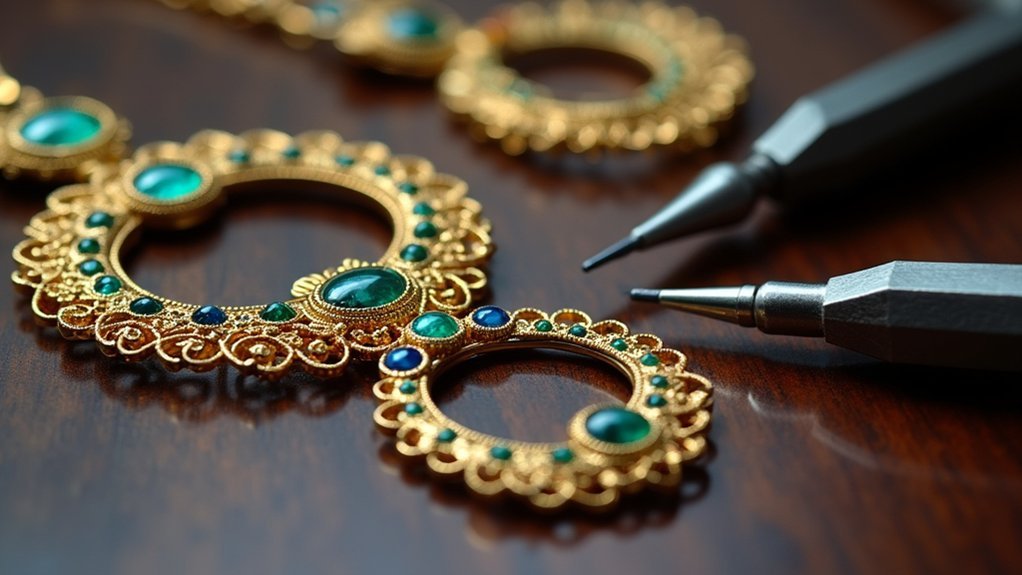



Leave a Reply